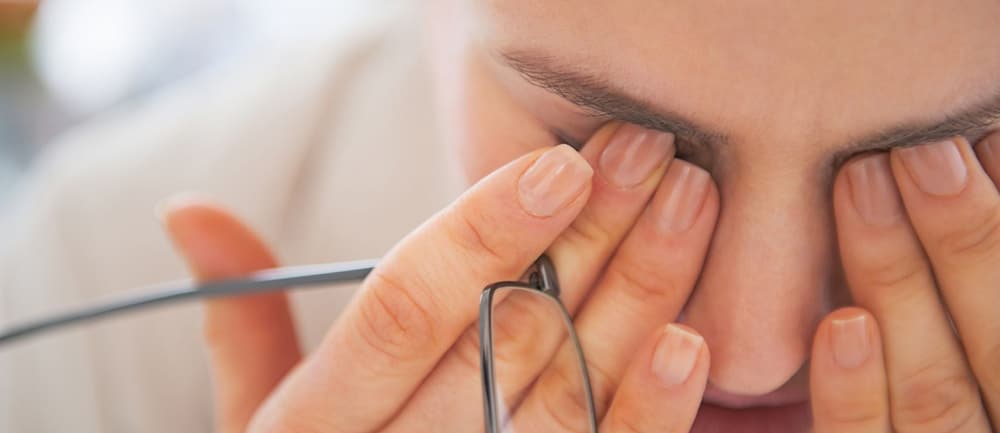Dry Eye
Do you suffer from irritation, tearing, itching, or redness due to dry eyes? At Traverse City Eye, our experienced eye doctors are committed to providing patients with the most advanced dry eye treatment and technology.
Traverse City Eye is proud to be Northern Michigan’s Dry Eye Center of Excellence! This designation is only given to ophthalmologists who have received extensive training in diagnosing and managing dry eye.

What is Dry Eye?
For the surface of your eyes to be healthy, they need to be adequately lubricated with tears. If your tears are not good quality or your eyes are not producing enough tears, they can become dry.
The clear dome-shaped window at the front of your eye is called the cornea. The cornea needs to stay lubricated for you to be able to see clearly and for your eyes not to feel dry. There are three main components of the tear film, which coats the surface of your eyes and keeps them hydrated. These three also make up the layers of a tear. The three components are water, oil, and mucus. All three of these components must be in the correct balance for your eyes to feel healthy and hydrated.
If your eyes produce too few tears, they will quickly become dry. If your tears are not correctly balanced with the correct amount of each layer, the tears will not be of good quality. If your tears are not of good quality, they will not properly lubricate your eyes, and your eyes will become dry.
What Are the Most Common Symptoms of Dry Eye?
The symptoms of dry eye, also called dry eye syndrome, can vary from person to person. Many people with dry eyes complain of itching, tearing, burning, crusting, and discomfort.
If your eyes are dry, your vision may fluctuate. Many people with dry eyes experience blurry vision that is sometimes worse than others.
What Causes Dry Eye?

Inadequate or poor-quality tears can cause dry eyes. Dry eyes can also be caused by a variety of other factors.
Some people with seasonal allergies suffer from dry eye during certain seasons of the year when their allergies are most active. If you notice sniffing, sneezing, or coughing at the same time as dry eye symptoms, your dry eye may be caused by allergies.
Another common cause of allergies is digital eye strain. Many people spend most of their day looking at their phone, computer, or TV.
When looking at digital devices or screens, you naturally blink less. Without blinking frequently, your eye’s lubrication will not be replenished and can become dry.
Certain autoimmune conditions and medications can also cause your eyes to be dry. If your eye doctor suspects the cause of your dry eye to be related to a health condition, they may send you to your primary care doctor for additional testing.
The best way to determine what could be causing your dry eye symptoms is to visit your eye doctor at Traverse City Eye. Your eye doctor will be able to diagnose you and find the root cause of your symptoms. Once your eye doctor determines the root cause of your dry eye, they can create a treatment plan to help improve your symptoms.
What Dry Eye Treatment Options Do Traverse City Eye Offer?
If you have tried at-home dry eye treatments and aren’t noticing a significant improvement in your symptoms, it may be time to visit your eye doctor. At Traverse City Eye, we offer a variety of in-office treatments that can help reduce many dry eye symptoms.
Prokera
One treatment option that the professional eye physicians at Traverse City Eye use to help treat dry eye is Prokera. Prokera is often used in advanced cases of dry eye.
Prokera is a device used by eye doctors to protect, repair, and heal damaged eye surfaces. Prokera is made by clipping a piece of amniotic membrane tissue between two rings made of a transparent, flexible material.
The amniotic membrane is part of the placenta and has natural therapeutic properties to help the cornea heal from advanced dry eye. Before your eye doctor installs Prokera into your eye, you are first given a numbing drop.
Your eye doctor will then place the Prokera lens onto your eye, similar to a contact lens. The Prokera device has proven to reduce inflammation and scarring in damaged corneas.
The device stays in place on your eye for three to five days, and then it is removed.
Restasis
Restasis is a prescription eye drop that helps increase your eyes’ natural ability to produce tears. Restasis can help those who experience dry eyes due to inflammation.
Inflammation can be due to certain autoimmune conditions. Restasis is an immunosuppressive medication that works to reduce inflammation in the tear glands.
Restasis does not increase tear production. However, reducing inflammation allows your eyes to produce healthier tears.
Restasis comes in single-dose vials and multidose vials and is most often prescribed to be used twice daily in both eyes. It can take time to see the results from Restasis.
You will need to be consistent in your treatment for it to work. You must continue to use the Restasis and not stop treatment if you don’t see results immediately.
Xiidra
Xiidra is another prescription eye drop that eye doctors use to treat dry eye. Similar to Restasis, Xiidra also aims to improve inflammation.
Xiidra targets the source of inflammation that causes dry eyes. Xiidra works by blocking a protein on the surface of cells.
The protein can reduce tear production or create tears that don’t properly lubricate your eyes. Xiidra can take six to twelve weeks to produce results, and you may not notice improvement right away.
Your eye doctor will see you frequently during your use of Xiidra to check for signs of improvement in your dry eye.
Biotissue Amniograft
Biotissue AmnioGraft is a biologic ocular transplantation graft used by eye doctors worldwide to treat eye surface conditions like dry eye syndrome. Many eye doctors use the Biotissue Amniograft to treat people with mechanical dry eye, also known as conjunctivochalasis.
Conjunctivochalasis is an eye condition that prevents your eye from holding tears. It can also cause irritation and discomfort in your eyes.
The Biotissue Amniograft replaces the tissue on your eye that causes conjunctivochalasis. It serves as a tissue replacement by delivering the unique healing actions of amniotic membranes.
Like Prokera, the Biotissue Amniograft uses amniotic membranes that are part of the placenta. Recovery from the Amniograft procedure is relatively quick, lasting only two to three weeks.
After the procedure, your eye will be able to hold tears adequately. The tears can then moisturize the surface of your eye, improving your dry eye symptoms.
Tear Care
Tear Care is a dry eye treatment many eye doctors use on people who have evaporative dry eye or meibomian gland dysfunction. Meibomian gland dysfunction, or MGD, is a common cause of dry eye.

The meibomian gland produces the oil needed for a healthy tear film. The oil allows your tears to moisturize and adequately lubricate your cornea. Those with MGD have meibomian glands that have become clogged or failed. The Tear Care treatment uses heat therapy in conjunction with the manual expression of the glands to help them rerelease the oil.
Tear Care’s wearable eyelid technology administers gentle heat directly to the meibomian glands during the treatment. The heat liquefies the solid oil clogged in the gland, removing blockages and stimulating tear production. After this, your eye doctor will use special tools and a microscope to help release the oils in the glands. Tear Care is a personalized, in-office treatment that takes about fifteen minutes to complete. Results can vary, but many people will notice an improvement in their dry eye symptoms in the weeks after the treatment. Some people may need more than one treatment to see the best results.
Are you interested in learning more about dry eye and the treatment options offered at Traverse City Eye? Schedule an appointment at Traverse City Eye in Traverse City, MI, today!
